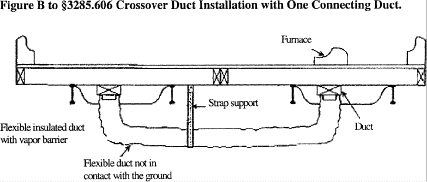Title 24
SECTION 3285.606
3285.606 Ductwork connections.
§ 3285.606 Ductwork connections.(a) Multi-section homes with ductwork in more than one section require crossover connections to complete the duct system of the home. All ductwork connections, including duct collars, must be sealed to prevent air leakage. Galvanized metal straps or tape and mastics listed to UL 181A (incorporated by reference, see § 3285.4), for closure systems with rigid air ducts and connectors, or UL 181B (incorporated by reference, see § 3285.4), for closure systems with flexible air ducts and connectors, must be used around the duct collar and secured tightly to make all connections.
(b) If metal straps are used, they must be secured with galvanized sheet metal screws.
(c) Metal ducts must be fastened to the collar with a minimum of three galvanized sheet metal screws equally spaced around the collar.
(d) Air conditioning or heating ducts must be installed in accordance with applicable requirements of the duct manufacturer installation instructions.
(e) The duct must be suspended or supported above the ground by straps or other means that are spaced at a maximum distance not to exceed 4′-0″ or as otherwise permitted by the installation instructions. When straps are used to support a flexible type duct, the straps must be at least 1/2″ wider than the spacing of the metal spirals encasing the duct. The ducts must be installed such that the straps cannot slip between any two spirals and arranged under the floor to prevent compression or kinking in any location, as shown in Figures A and B to this section. In-floor crossover ducts are permitted, in accordance with § 3285.606(g).
(f) Crossover ducts outside the thermal envelope must be insulated with materials that conform to designs consistent with part 3280, subpart F of this chapter.
(g) In-floor or ceiling crossover duct connections must be installed and sealed to prevent air leakage.
 Notes:
Notes:
1. This system is typically used when a crossover duct has not been built into the floor and the furnace is outside the I-Beam. With this type of installation, it is necessary for two flexible ducts to be installed.
2. The crossover duct must be listed for exterior use.
 Notes:
Notes:
1. This system is typically used when a crossover duct has not been built into the floor and the furnace is situated directly over the main duct in one section of the home. A single flexible duct is then used to connect the two sections to each other.
2. The crossover duct must be listed for exterior use.